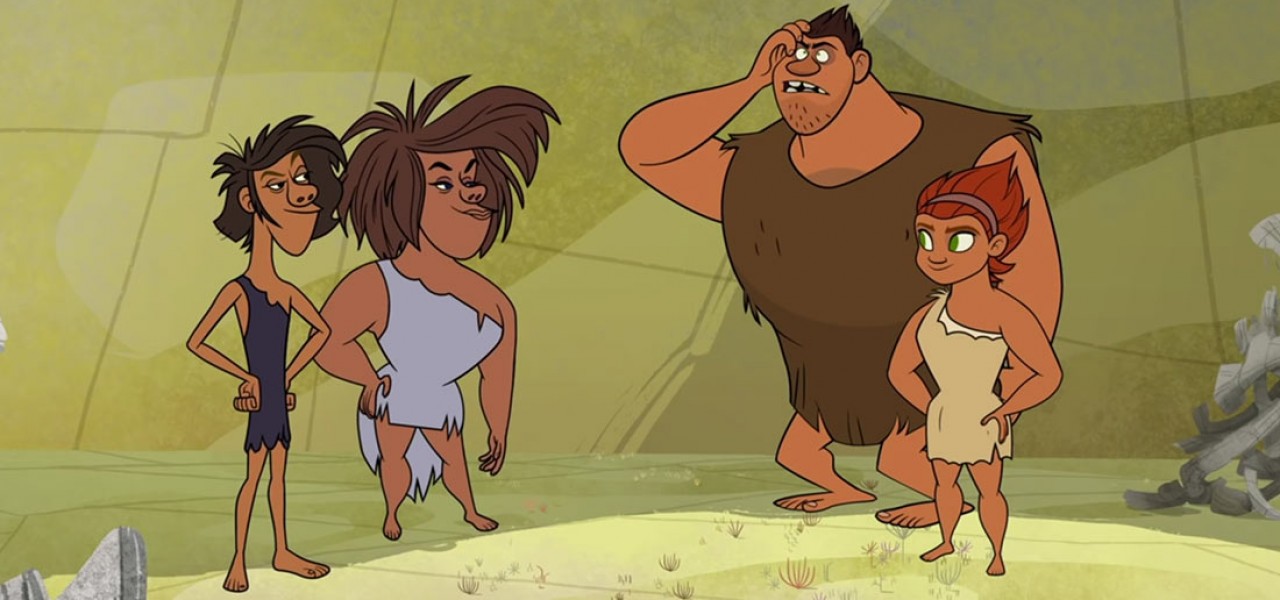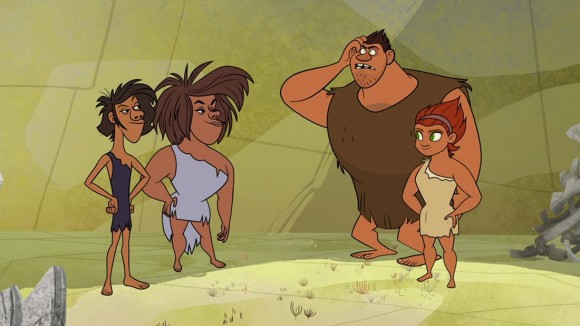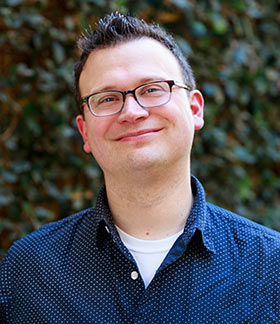

‘Dawn of The Croods’: Brendan Hay Discusses Building A Kinder, Gentler Animated Apocalypse
The Croods have arrived in series form, and death is still around the nearest rock. Dawn of the Croods, however, is playing imminent demise for laughs.
“We have to make sure death plays more funny than sad,” executive producer Brendan Hay (The Simpsons, The Daily Show) told Cartoon Brew by phone, shortly before DreamWorks’ Christmas Eve premiere of Dawn of The Croods on Netflix.
DreamWorks’ new animated prequel series is also different in that it is a hand-drawn affair, rather than the blockbuster CGI apocalypse that made The Croods one of the studios’ most underrated productions. Whereas The Croods found its first human family surviving extinction thanks to new thinking from its powerful female lead, Eep, Dawn of The Croods places them back amongst their neighbors before everything went to literal hell. It’s a clever prelude to The Croods’ shifting 2017 feature sequel, which focuses on Ugga and motherhood, according to co-director Kirk DeMicco.
Cartoon Brew caught up with Dawn of the Croods’ Hay to talk about how and why his cartoonish 2D prequel series works as bridge to an expanding CGI film franchise, which is about a family that, thankfully for animation, doesn’t have to die apart to learn how to live together.

Cartoon Brew: The Croods was one of DreamWorks best animated features so far. What’s the plan for adapting it to television?
Brendan Hay: The Croods was one of my favorite DreamWorks features as well. I loved how it managed to carefully balance a modern, relatable family dynamic between characters with a caveman’s point of view. I love The Flintstones, but it was always about transporting the modern world’s conveniences into its time period. The Croods took the time to create an experience based on how a cave family would live, which surprisingly hasn’t been done that often, at least for comedy.
The only condition going in was that Dawn of The Croods had to be a prequel, because the next feature film is going to be a sequel. So my thinking went to what the first family sitcom in history might be like. There’s a sentence in The Croods’ prologue where Eep explained that they used to have neighbors, which sounded like a fun world, so we decided to build that out. What would be The Croods’ version of The Simpsons’ Springfield? If we put them into situations that modern families like ours understand and take for granted, how weird, strange or funny could it be? These became the comedy engine that built a whole neighborhood of families and friends around The Croods — called “Aaah! Valley,” named after the last words of its founder.
What helped The Croods stand out, particularly in animation, was that it was anchored by Eep, a physically and mentally strong female lead. How does the show plan to handle her?
Brendan Hay: We’re trying as much as we can to keep that alive. Eep is such a strong female lead, so our show is the prequel to Eep’s coming-of-age, which is what The Croods is about. In the feature, she’s rebellious from the second we meet her. Dawn of The Croods finds her a few years earlier, before she reaches that place. She’s just starting to realize that she wants to rebel, and do her own thing. But like many kids, she’s not yet sure exactly what her thing is. But she’s still headstrong and confident, so whatever she does decide to do, she dives in 110 percent.
How about the father-daughter relationship? In The Croods, Grug was a stubborn remnant of devolved thinking which almost drove his family to extinction, whereas Eep was forward-thinking and pushed them to survive.
Brendan Hay: One thing I really liked about The Croods was that it starred a family who truly loved each other. It wasn’t just them taking shots at each other. So we’re trying to keep that dynamic alive. At the same time, I think what you said about generational difference is very true here. Much of Dawn of The Croods’ comedy comes from Eep and Thunk, who are often correct because they’re the ones who are starting to think about easier and smarter ways to do things. But in their world, there still is a lot of, “Oh, you kids and your crazy ideas!”
You worked on The Simpsons, and their name has already come up, so I’m wondering if the two merged at all while you were conceiving and producing Dawn of The Croods?
Brendan Hay: A little bit. We always use The Simpsons in the writers’ room when we’re trying to communicate an idea in shorthand. I think it’s impossible to make an animated family show that isn’t in some way inspired by The Simpsons. That’s the bar everyone is trying to reach. We are trying to borrow some of their dynamic, but Dawn of The Croods is also building on the feature’s great action — from the hunt at the beginning to squashing and stretching Grug during his reactions to pain. We’re trying to be more cartoonish in that way than The Simpsons would be on average.
But also, at the heart of our show, and The Croods, is the fact that death could be just around the corner. A lot of Dawn of The Croods’ humor is about pain or the threat of death, so we really need things like squash and stretch more than other family cartoons. We have to make sure death plays more funny than sad.
Speaking of, another thing I loved about The Croods is that, unlike so much family animation, no one in the film’s family had to die so the kids could learn something. They all got to live and learn together, which is how most families work.
Brendan Hay: Exactly! You didn’t have that usual thing, where the lead character now has to stand alone. Its like, “No, you actually have to learn how to live with your family, and work together.”
A great, and quite topical, dimension of that dynamic is that The Croods live in a period of significant environmental destabilization. How does the environment, which is where much of film’s danger came from, play in Dawn of The Croods?
Brendan Hay: Because our show is a prequel, the world is a little more brand new at this point. The Croods begins with the whole world coming to an end, so we’re assuming things start to go really bad somewhere between the end of our series and the feature. So for us, Dawn of The Croods is a slightly more hopeful time, before resources dry up and Grug becomes terrified of the world around him. It’s a vibrant, new place the family is still discovering.
Also, on a design level, we realized that if we were to completely embrace The Croods’ initial desert landscape, we’d run the risk, especially in 2D, of looking like The Flintstones and other caveman cartoons, or Wile E. Coyote and Road Runner. How do we relate to the film, but still have our own space? The Croods got away from the desert after its first 20 minutes by plunging into a lush, new jungle. We can’t do that, so we created some vegetation and crazy rock formations, before the crippling drought set in, to bring in more color and vitality.
Can you talk a little bit about where the animation was made.
Brendan Hay: Like a lot of DreamWorks shows, we do all the pre- and post-production here, and animate with partner studios. Early on, we weighed the pros and cons of 2D and CG, but opted for 2D for two reasons. One is that we wanted Dawn of The Croods to be cartoonish. On a feature budget schedule, you can make great squash and stretch in CG, but it’s tougher for television. The other is that, since both our show and the feature will live side by side on Netflix, we wanted viewers to know right away which Croods they are watching.
Once we chose 2D, we initially planned Dawn of The Croods to be a Harmony-based show. We were working with Bardel in Canada, but unfortunately we found that Harmony wasn’t the best fit for what we were doing. Bardel was a fantastic partner, but because we really wanted to build out a neighborhood around our family, which has six characters, it became tough to use Harmony whenever we got to scenes with more people. So I think three of the first 13 episodes that come out on the 24th were made with Harmony and Bardel, while the rest of them were traditionally hand-drawn with out studio partners in South Korea, EMation, NE4U, and Dong Woo Animation.
(Top image: DreamWorks Dawn of the Croods 2015 DreamWorks Animation LLC. All Rights Reserved.)

.png)